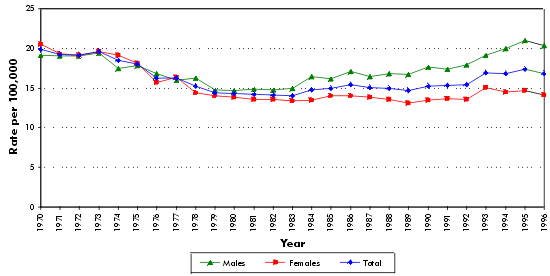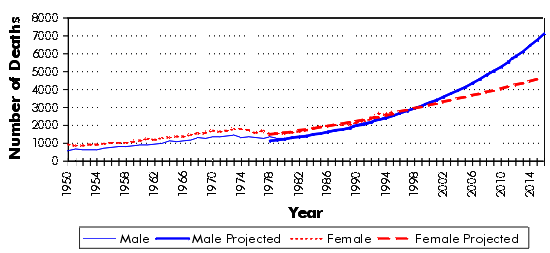Common menu bar links
Institutional links
Diseases & Conditions
Health & Safety
Research & Statistics
Agency Information
Search Box
E-mail this page
Diabetes in Canada
MORTALITY
Number of Deaths
There were 5,447 deaths (2,701 males; 2,746 females) in 1996 for which diabetes was certified as the underlying cause of death (Statistics Canada Mortality Database). This ranks diabetes as the seventh leading cause of death in Canada.
However, the actual number of deaths for which diabetes was a contributing factor is probably five times this number according to recent Canadian studies. People with diabetes usually die from the late complications of the condition, such as ischemic heart disease, and it is these complications that are, in most cases, coded as the underlying cause of death.
Diabetes Mortality - Underestimation
A recent Statistics Canada study of all deaths from 1990 to 1993 found that diabetes was coded as "underlying cause of death" in only 28% of cases in which diabetes was mentioned on death certificates(16). In the remaining 72% diabetes was mentioned as a contributing cause. Compared with all causes of death, diabetes had a very high ratio of mentions on the death certificate to selections as the underlying cause of death. Thus, using underlying cause of death alone will capture fewer than one third of all diabetes-related deaths. This study did not include deaths related to diabetes that were not coded on the death certificate.
A study in Prince Edward Island (1982-1984) identified people with diagnosed diabetes and matched these cases to death certificates(17). It was found that for 41% of all people with diabetes who died in that time period, diabetes was not mentioned on the death certificate at all. Of these, 66% had an underlying cause of death coded as cardiovascular disease, gangrene or renal disease, and these can be considered uncertified diabetes-related deaths. The percentage of death certificates mentioning diabetes for which diabetes was identified as the underlying cause of death was similar to the above-mentioned Statistics Canada study, at 29%. When all diabetes-related deaths (certified and uncertified) are taken into account, the actual number of deaths for which diabetes is a contributing cause is probably over five times the number coded as underlying cause (LCDC estimate, 1998).
Age-Standardized Rates by Sex
The current (1996) age-standardized (to the 1991 population) mortality rate for diabetes in Canada is 16.8 per 100,000 population (Figure 15). Age-standardized mortality rates have increased since the early 1980s because of increased mortality rates for diabetes among males; in 1996 the rates were 20.4/100,000 and 14.1/100,000 for males and females respectively.
FIGURE 15
Age-standardized diabetes mortality rates (/100,000),
by gender and year - Canada, 1970-1996

ICD-9 Code 250 Diabetes; Standardized to 1991 Canadian
Population
Source: LCDC 1998 - using Statistics Canada Mortality
Data
This increase in mortality rates could be related to an increase in the number of new cases of diabetes (incidence) or a decrease in the quality of care leading to earlier deaths after diagnosis. However, a higher incidence of diabetes is the most likely cause, given (i) the trend toward increasing prevalence of diabetes from 1994 to 1996 and (ii) the increased prevalence of obesity, which is the primary risk factor for Type 2 diabetes. There is no evidence that the quality of care for diabetes has decreased in recent years.
The increase in diabetes mortality rates is occurring over a period of time when the mortality rates for cardiovascular disease, the main cause of death for people with diabetes, are decreasing, likely because of better management of other risk factors for cardiovascular disease, such as smoking and hypertension, as well as improved treatment of cardiovascular disease in the general population.
Age-Standardized Rates by Province
The five-year (1992-1996) average age-standardized mortality rates for diabetes by province show Newfoundland with the highest diabetes mortality rate (Figure 16). The rates in Yukon and the Northwest Territories are based on a small number of cases (12 and 3 cases respectively). Death certificate coding procedures may vary by province and territory.
FIGURE 16
Age-standardized diabetes mortality rates (/100,000) from
1992-1996 (5-year average) by province and territory -
Canada

ICD-9 250 Diabetes; Standardized to 1991 Population.
* The actual number of deaths in the territories is 15.
Source: LCDC 1998 - using Statistics Canada Mortality
Data
Age-Standardized Potential Years of Life Lost (PYLL)
Approximately 25,000 PYLL were lost because of diabetes prior to age 75 in 1996, representing an age-standardized rate (standardized to the 1991 Canadian population) of 85 per 100,000 population (Figure 17). The crude 1996 PYLL (prior to age 75) rate is 88 per 100,000. Since 1983 there has been an increase in the age-standardized PYLL that can be attributed primarily to increases in mortality rates among males aged 60 years and over.
FIGURE 17
Diabetes: Age-standardized potential years of life lost (PYLL)
prior to age
75, by gender and year - Canada, 1950-1996

ICD-9 Code 250 Diabetes; Standardized to 1991 Canadian
Population
Source: LCDC 1998 - using Statistics Canada Mortality
Data
Trends and Projections
Projections of diabetes mortality trends into the year 2016 show an exponential increase in the number of diabetes deaths among males and a more linear increase among females (Figure 18). Projections were modelled on the basis of diabetes deaths (counts and age-specific rates) from 1978-1995.
FIGURE 18
Number of diabetes deaths (1950-1995) and projections to year
2016, by gender - Canada

ICD-9 Code 250 Diabetes; projections based on deaths from
1978-1995.
Source: LCDC 1998 - using Statistics Canada Mortality
Data
[Previous] [Table of Contents] [Next]
